More than just a face-lifted Mustang: The early Cougar market isn’t easily defined
“During the past few years, thousands of motorists have asked for a larger car than the Ford, with all the fundamental virtues and advantages of the Ford V8, and priced according to Ford standards of value.”
While the quote above was taken from a 1939 Mercury sales brochure, it encapsulates Mercury’s mission to spin off a version of Ford’s wildly successful pony car for themselves. Much like the Mercury’s prior successes, the 1965 Mustang’s blueprint easily translated into a premium pony car: more wheelbase with unique sheetmetal, a standard V-8 engine, memorable fascias front and rear, and an option package providing an interior akin to a luxurious Jaguar. It even received an appropriately feline name to boot: Cougar.
The Cougar slotted well into Mercury’s mission, as the aforementioned Jaguar-themed grand tourer was priced between the Mustang and the prestigious Thunderbird, and provided Lincoln-Mercury dealerships with another high-volume vehicle. It was a delicate balancing act, one that kept dealers on both sides of the Ford spectrum happy. It didn’t hurt that the Cougar was able to do everything a Mustang could, but with more space and grace.
More to the point, a top-spec Cougar XR-7 GT in 1967 came with Ford’s 390-cid FE motor, a handling-oriented suspension, and that ritzy leather/faux wood interior. It was priced disturbingly close to that of a base Thunderbird, but that only made the Cougar’s mystique even more romantic. Consider the first photo below, as Ford had the nerve to project the 1967 Cougar logo onto the GM building, sort of a public relations coup for their premium coupe. That’s certainly a moment in time we will never see again.
Then consider the Cougar’s competitive pedigree —with no less than Dan Gurney behind the wheel, it came within spitting distance of beating the Mustang in SCCA’s 1967 A-Sedan manufacturer’s championship. Off the track, adding the XR-7’s leather and burl wood(ish) trimmings gave the Cougar a fighting chance in its battles with aloof GT cars from Europe. A comparison test with an Aston Martin DB6 isn’t necessarily a trivial exercise: while the aforementioned Cougar XR-7 GT is longer and has a far more monstrous engine, the weights are similar and performance was shockingly comparable. That’s provided you neglect the Aston’s prestigious refinement and consider the Cougar’s more modest asking price. But again, this is another circumstance we will never see again.

That’s because time pauses for no one. By 1973, the now-second generation Cougar suffered from the same bloat and reduced performance as its Mustang brother, losing its famous electric shaver covered headlights in the process. The Malaise Era forever changed the pony car, so it’s no surprise that future Cougars went all-in on their luxurious heritage. The jump to the Ford Torino platform in 1974 signaled the end, even if the act created the best selling Cougars of all time. Subsequent Cougars moved to the Ford Fairmont, Thunderbird and even the Mondeo platform, and many examples were true to the performance/luxury value proposition of the original. Too bad that two-portaled ship had sailed, never to return.

With Mercury’s empty slip in the boatyard of automotive history came misinformation to fill its space. And one particular myth about the original Cougar endures: it is just a Mustang with different bumpers and lights. There are variations of that theme, but the lights/bumpers comment was something I overheard while waiting in line for the airport ticket counter. Of course I couldn’t leave well enough alone, as the slow burn of waiting for a plane ticket (pre-paperless days, mind you) got to me.
So I gently, courteously, reminded my fellow passengers that the first Cougar “shared almost nothing with the Mustang aside from the windshield.” That’s factual, but also difficult to argue in a public setting. The subsequent conversation about wheelbase, engine differences, and the Cougar’s standard equipment turned a few heads out of curiosity, but imagine if those folks had said that a Mustang was just a Falcon? That would likely have triggered an intervention from the TSA!
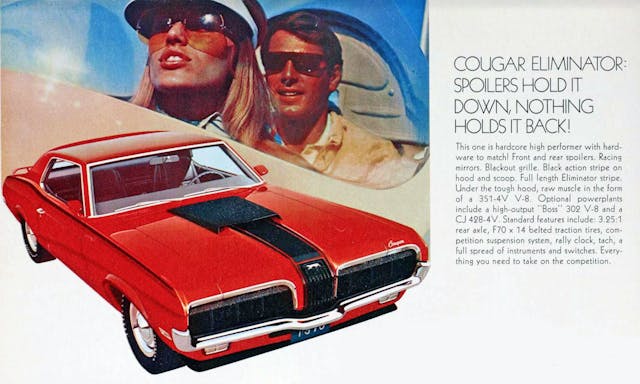
So what actually made the Cougar so special might be lost to time, but perhaps some data will right the ship. The Cougar may live behind the Mustang’s long shadow, but more younger folks are taking interest in the old cat. Millennials and Gen-X make up 19% and 35% of interest (insurance quotes, respectively) these days, and we expect Gen-X to be the largest portion of first generation Cougar owners in the near future. Boomers are currently at 36%, while Gen-Z and Pre-Boomers are at 5 and 3%, respectively. Cougars like the 1970 Eliminator (above) are no slouch in terms of market valuation, as those spoilers really speak to the market.
The days of pulling a big-block 1970 Cougar out of a barn for a few hundred clams is long gone, and the cosmetic tweaks offered by the Eliminator provide period-correct style for roughly 85% more than an XR-7 with the same Cobra Jet motor. The same applies to the base model when Cobra Jet–equipped, as it is about half the price of the XR-7 above it. Last year was a good time to own a 1970 Cougar, as prices shot up across the board and most have plateaued ever since. Muscle and pony cars from the heyday of Detroit performance set a high watermark for many iconic automotive brands, and high tide lifted all boats, even those made by the Lincoln-Mercury division. Provided they are the ones with spoilers, racing stripes, and names that evoke the performance expected from the era, of course.
The earlier first-generation Cougars aren’t fairing quite as well, possibly because more units were sold (150,893 units in 1967, versus 72,343 in 1970), there was a smaller big block, and the emphasis was on touring luxuries instead of overt, racy trim packages. But the big block 1967 Cougars still do well, spiking in 2022 just like the 1970 models. The small blocks have been more volatile over time, and a 390 big block Cougar is worth 25% more than a small block XR-7, and a whopping 44% more than a base small block Cougar.
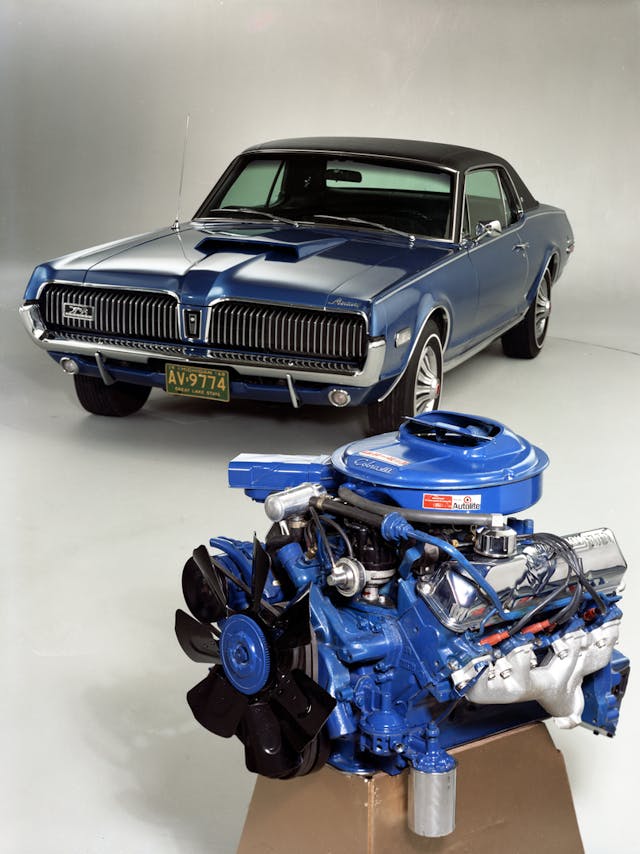
It’s ironic that the original Cougar had strong sales when new, but its focus as a high-value alternative to Jaguar hasn’t reaped the muscular, big blocked transaction prices generated for the revised 1969-70 model in 2023. On the plus side, this makes the 1967 models more approachable for the younger generations that are clearly finding good reason to visit The Sign of The Cat. While a tragic amount of the Cougar’s mystique has been lost to the sands of time, the diverse entry points and significant interest from Gen X and younger buyers may well bring in more soon-to-be loyalists. Those new, true believers will understand what made the first-generation Mercury Cougar special over its Mustang counterpart.
***
Check out the Hagerty Media homepage so you don’t miss a single story, or better yet, bookmark it. To get our best stories delivered right to your inbox, subscribe to our newsletters.
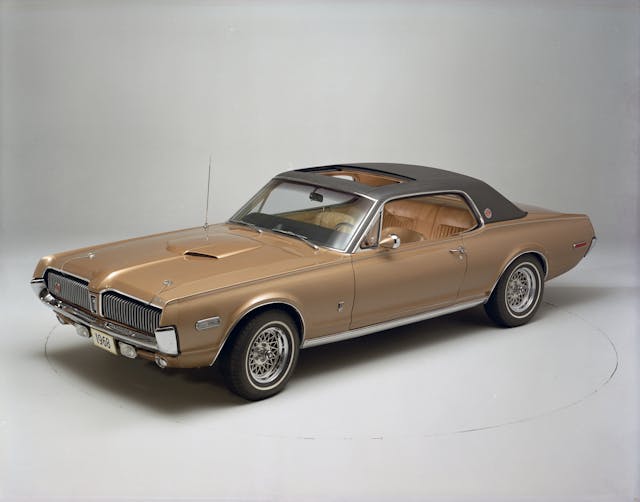
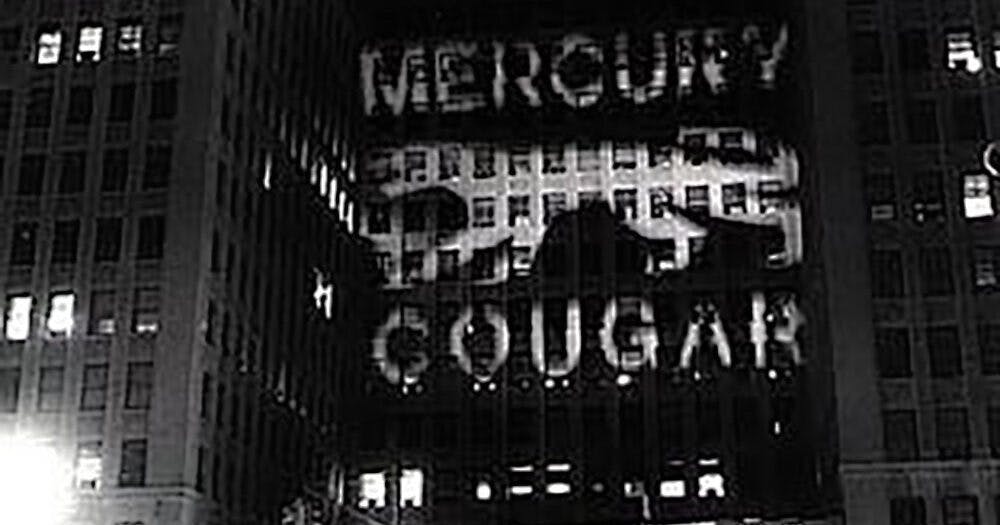
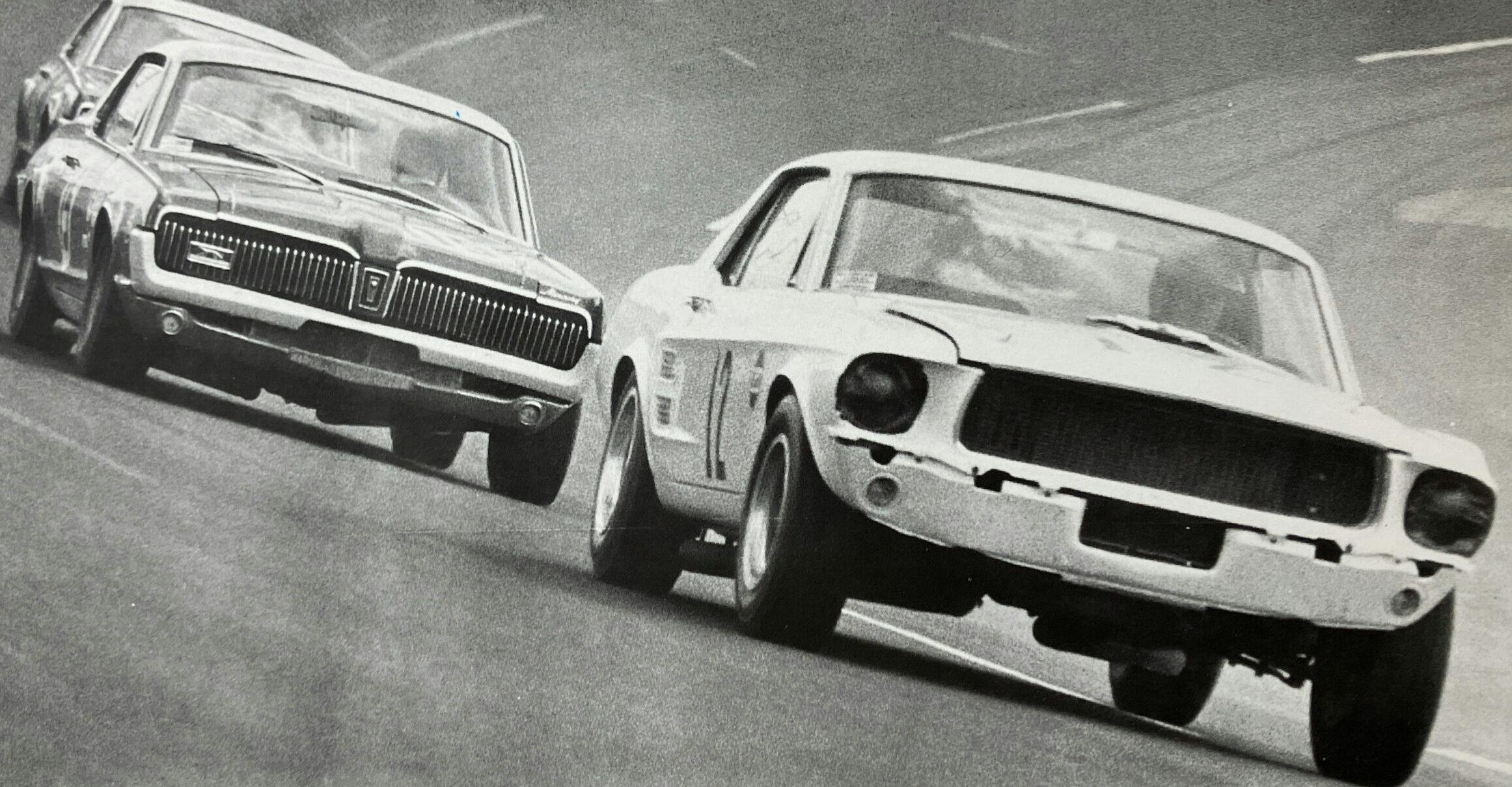



Bought a 67 base model from my dad when I was 16, drove it decades and sold it in my 40’s. Great all-around car, it helped pay for college- people would hit me and I would buy another can of bondo and keep the insurance money. My wife hoped to buy it back somehow for me, and she was contacted on facebook and told that the car was available if we wanted first dibs. I paid twice what I sold it for, but it was in terrible shape; even rust holes in the dash, many parts missing. Slowly bringing it back to life, but I really enjoy it. I agree that the 69’s are nicer looking, but I like the interior of my base model 67.
Sajeev
Well done, it’s about time someone stood up to the “experts” and set the record straight about the mechanical heritage of the Cougar.
I bet you could go to any higher end Cars & Coffee and 70% of the car guys would not know about the wheelbase stretch.
In reading your piece, you make a compelling argument….a sporty mono (or Lincoln) makes a lot of sense.
While the two new Mustangs I bought in my youth had decent interiors and refinement, later generations were less impressive. I liked the look of the many, bit was put off by the extra cheesy interior plastics and lack of….well…grace, space and pace (to borrow a classic Jaguar ad).
So, I kept my Mercedes CLK. I have always called it my “Mustang for grown ups”.
Yes, it cost a lot in 1999, but 24 years later it still looks great and is comfortable. I’d be on my second or third Mustang by now.
If I had been a few years older (and could afford it), I would have been sorely tempted by the Cougar’s wood dash with toggle switches, console and overhead map lights and the rest.
The basic idea would still be tempting today, a Aston Martin inspired Mustang instead of a budget racer (faux Shelby) aimed at ” Fast and Furious” fans with fake scoops in the front facia.
Then Detroit probably wonders why people buy BMWs (before the ghastly new look), Audis and Mercedes.
Glad you enjoyed the article, and yes, it high time we do our share to stop the myth of these cars.
Somewhere out there is a one-off Cougar XR8 that the Deuce had finished for him…a 68-68. Candy Apple Red with white leather, his initials engraved into the seat belt buckles and stitched into the white leather seats. He, my Dad, and my uncle were life long friends and Uncle got that car. What a beauty. Sold when Uncle knew his time was limited…what a stunner! It had next to no miles and probably still doesn’t. Anyone know where it might be???
Is this the third time I have seen this article? Anyway I like the ’68 myself.
My wife and I visited some friends in Detroit in the early 70’s and we stopped off at River Rouge to take a tour of the Ford plant. We were not surprised much to see the Cougars and Mustangs coming off the line intermixed together.
Fun fact: years before their production launches, BOTH (Ford) Cougar and Mustang names debuted in concept form as 2-seaters. The Cougar actually first as a Ford-nameplate 2-place GT coupe around 1960, and later, a second-gen version (Cougar II) based on a 289 Cobra chassis in 1963. The Mustang also debuted originally as a V-4 mid-engine roadster at the same time as Cougar II; the ‘Mustang II’ name was first used on the front-engined 4-place convertible concept car that previewed the production 1964 1/2 Mustang.
What a well written article!
Years ago a fellow with an automotive blog made the mistake of saying the Cougar was an upscale rebadged Mustang and got a lot of angry replies that the Cougar in fact had a lot of unique sheet metal and a longer body.
A buddy at work had one of the first generation XR-7 Cougars and I always like it. Refined was a well deserved label. As many said here, most folks saw the Cougar as a “fancy Mustang”. Caught between the youthful Mustang and mature driver luxury Thunderbird, it was a great car without only a small buyer pool. When the 69 Cougar got the “Buick” body side swooping crease I lost all interest in the Cougar, then the bulbous barges came along. Now it is difficult to find Cougar trim parts vs. the Mustang. Still, if I found a nice one with all the trim intact I’d be tempted.
I agree, I hated the Buick sweeps.
Whose idea was that?
Might have made sense if the other Mercurys had them, but they didn’t.
I liked the Cougar but when I traded my wife’s Maverick back in ‘72 it was more expensive than the Mustang ( or the Camaro) so I bought the 1973 Mustang. She drove it for 25 years until it got rear ended. It was still in great shape but the insurance wrote it off due to the repair cost. She cried😢😢
Also, back in ‘93 I bought a T Bird for my wife. She drove the Cougar which had a similar body style but the rear window was narrower and difficult to see out of. I agreed and we got the Bird. Otherwise the cars were the same.
I am sick and tired of Hagerty cookie notifications each and every time I try to read and article. I make my selections and set them as my permanent selection…until the very next email. Ahhhhhg!!!!!
Never an issue with any other platform. Can we get a 12-year-old to write a better program please????
In 1970 I wanted to buy a ’67 fastback Mustang but they cost more money than a ’67 Cougar. I wanted a big block too. So I bought a ’67 Cougar with one and a 4-speed. A great car, I had a lot of fun with it. It never needed to go into the shop for repairs. The GT option gave better handling and I liked to throw that car around. It could do 130 mph. I still have the engine and 4-speed.
Always loved the 67/68. Looked at them several times when they were a couple years old but they were just priced a hair above what I could afford. I still look at them today and love the style, they just have class. When I was 16 I had a 61 mercury Monterey, black with black interior, plus a 390, then bought a two year old 65 Cyclone. Would love to have both those back
What a silly article! Who ever wrote this article is not familiar with real muscle cars! A 1939 brochure? That’s ridiculous! Real journalists always check for typos. This fiction writer couldn’t get a fact right in any manner.
My high school car (1971) was a base 67 Cougar, great car. I like the fact that my 67 Shelby GT500 has the Cougar tail lights 🙂
Had a 1969 XR7 in 1972 great car should have never sold it. Just bought another with 57,000 miles. Beautiful Automobile. I’m 17 again.